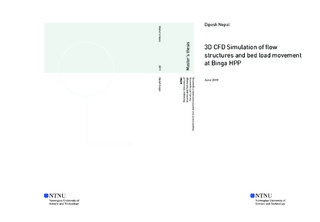| dc.description.abstract | The present study aims to perform three-dimensional numerical modeling of a water reservoir called Binga situated in Philippines. The hydraulic and sediment simulation should be performed. A working hypothesis on how to transport the bed load should be made and its modeling should be done.
The numerical modeling program used for simulation is SSIIM 2, developed at NTNU by Professor Nils Reidar B. Olsen. This program is capable of modeling sediment transport with a movable bed and varying water level. Due to this reason, it is a powerful tool to simulate both sediment deposition and reservoir flushing.
The Binga HPP was commissioned in 1960 with an original storage capacity of 95 mill. m3. By the survey of 2015, it is found that the volume dropped to 21 million m3 resulting in only 22% volume left in the reservoir. The storage capacity is still decreasing and the sediment delta that is deposited is advancing towards the intake. Therefore, there is a high risk of intake being clogged. Because of this heavy sedimentation problem, the project is aimed to be converted into the run- of- river scheme. By doing this the reservoir is allowed to be filled up or the volume is kept as it is as much as possible and it is made sure that intake is not clogged by the sediments.
Both the hydraulic and sediment simulations (bed load) were carried for different discharge conditions and different operational rule of the reservoir. Necessary algorithms and parameter settings were finalized from hydraulic simulations which were used in the simulation of sediments. From the sediment simulation, it was proved that the risk of intake being clogged increases if proper sediment handling measure is not considered. A hypothesis was made that sediment routing approach (guide wall installation) can stop bed load transportation towards the intake. Based on this hypothesis, the geometry of the reservoir was changed by making a guide wall such that incoming sediment load is passed through the spillway and simulation was performed. The result of the simulation showed that by adopting this approach the bed load can be stopped from approaching the intake and the risk of intake being clogged will be reduced.
During the simulations, challenges were faced due to poor convergence of the solution. In many cases, changes in parameters of algorithms helped to improve the convergence. Assumptions on sediment concentration and granulometry have been made during the simulation of sediments due to lack of data. So, there are still many uncertainties related to input data and algorithms used. Further work on the model and result verification are therefore recommended. With more testing and development, the model can be used to predict future scenarios with more accuracy. | |
